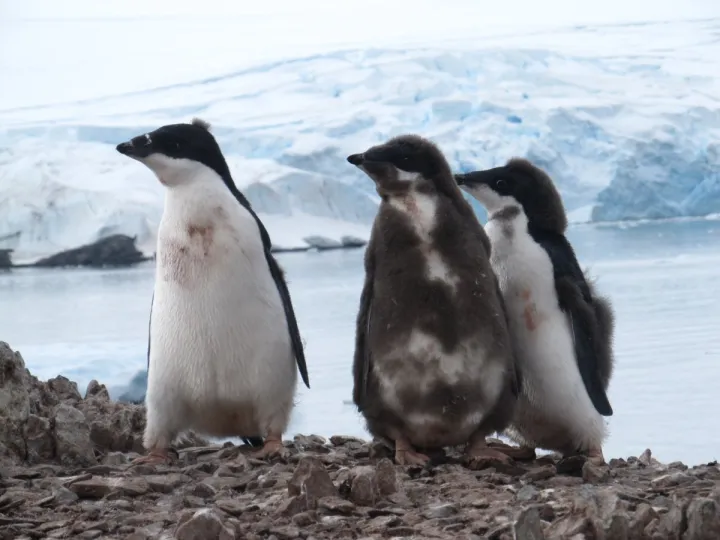Shipboard Life in the Antarctic

Strapped in to a harness on the back deck of a 230-foot research vessel off the coast of Antarctica, I take a moment to take in my surroundings. For as far as the eye can see bleached white ice floes jigsaw the open ocean, save for a distinct, unnatural channel our icebreaking hull has masterfully carved. The occasional lazy crabeater seal nods its head in acknowledgement as it drifts by atop one of the ice floes and a few Adélie penguins flit across the water between the large tiles of ice. For a second I am at peace. But the whine of a winch and a holler from my coworker brings me back to the task at hand. Our two-meter-long net, after a half hour of sifting through the ocean hundreds of meters beneath the surface, is set to return. Its contents will be sorted and preserved for scientific analysis.
It’s time to get to work.
The West Antarctic Peninsula is one of the most rapidly changing regions in the world due to climate change. Its cold, icy environment is home to an exceptionally diverse and productive ecosystem, but many of the plants and animals that rely on the cold temperatures are struggling to cope with the changing conditions. In January and February of 2016 I worked on the Research Vessel (R/V) Laurence M. Gould as a research technician with the Palmer Long Term Ecological Research project—a multi-team, long-term study that monitors the vast and unique Antarctic ecosystem. Both biological and environmental conditions were studied during this 6-week cruise. Different teams focused on zooplankton (krill), bacteria, phytoplankton, birds, whales, and physical characteristics of the ocean.
But don’t let the term “cruise” fool you. Life on an Antarctic research vessel is tough both physically and mentally. As you might imagine, the logistical coordination of an Antarctic expedition requires a bit more than booking a flight on Expedia and getting a room at the Marriott. Living at the bottom of the world requires an incredible support staff, a tremendous amount of physical work and a tight-knit community, all dedicated to obtaining critical insights into how the ecosystem will fare in years to come.
Getting to Antarctica is a task in itself. After 26-hours in transit, including flights and layovers, to the tip of Chile we must then take the R/V Gould across the infamous Drake Passage—a three day sometimes spectacularly rough journey. Consider that it takes astronauts just under six hours to arrive at the International Space Station. While in the Drake Passage the newbies quickly learned a tenet of ship life: don’t leave anything unsecured on a countertop. Our arrival at Palmer Station, our home base and one of three United States Antarctic Program stations, is highly anticipated (especially for those fighting seasickness).
The Gould is the life source of Palmer Station, bringing all the supplies and resources needed, including fresh fruits and vegetables (affectionately named “freshies”) every few months. On the ship we enjoyed four meals a day; your standard breakfast, lunch, and dinner and a fourth meal of assorted food called mid-rations (or mid-rats) at midnight. My favorites were taco and pizza nights.
Conducting science in one of the remotest parts of the world requires a few sacrifices on the part of the scientist. Tight quarters for two consist of a bunk bed nestled at one end of a room, a desk, cabinets, a bathroom and (if you’re lucky) a porthole. Taking a shower requires mastery of the power stance, a talent that involves balance and strength, usually acquired by the end of week one. Sleep—despite the occasional jolt, the bone crunching sound of ice crumbling underneath the hull, and the constant chirping of the SONAR—came easily thanks to the long hours and demanding physical work.
A standard scientific work shift lasts roughly twelve hours. My shift as part of the krill team was from midnight to noon, yet it seemed like any normal day since it is summer in January in the Southern Hemisphere and there is almost constant daylight. Teamwork is essential on a research vessel and most days we would elect to help the next shift with processing samples. The most time consuming work was counting and identifying the tiny animals we caught in our nets, but we also ran experiments to determine how krill affect the planet’s carbon cycle through phytoplankton consumption and excretion. Krill poop sinks like a deadweight to the bottom of the ocean, taking significant amounts of carbon with it. In addition to understanding how climate change is impacting the Antarctic environment we also collected data on how biological processes, like krill pooping, factor into climate models.
Working the back deck and deploying the two meter net tow. Photo credit: Julian Race
Despite the long work hours, we managed to have a little bit of fun during our time off. Beyond the go-to movie of the day, games were a popular pastime—we hosted bingo nights, cribbage tournaments, the occasional larger-than-life game of Mafia, and played Settler’s of Catan. By the end of our research cruise the hallways were ornately decorated with coloring book artwork and a few members of the ship would occasionally serenade us with their voices and instruments.
Despite mild discomforts, working aboard the R/V Gould was an amazing experience. At the end of the day after hours of work, a sense of accomplishment sets in, knowing that scientific understanding of this unique and now threatened ecosystem is advancing.
Editor’s note: If you’re curious about more of the science from this trip check out Danielle’s personal blog and the Palmer LTER website.
The Laurence M. Gould attempts to dock at Palmer Station amid icy conditions. Video Credit: Julian Race


